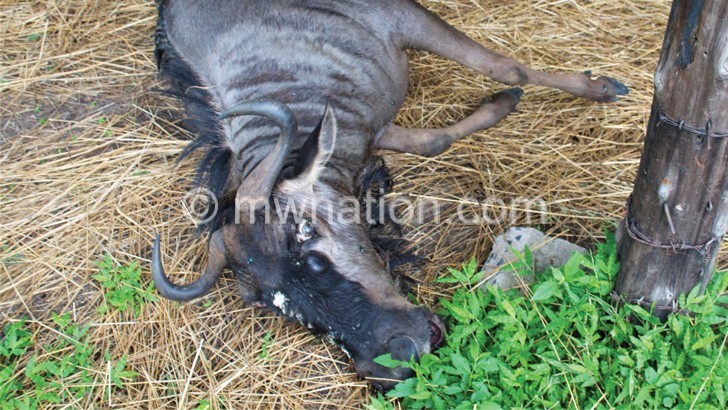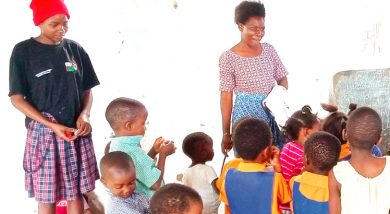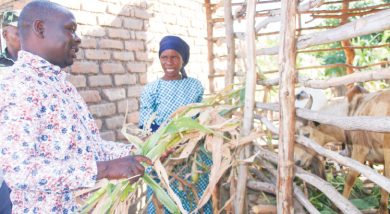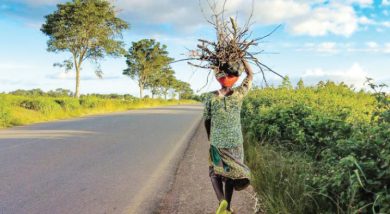Enter silent wildlife killer
While guards armed with rifles patrol protected wildlife reserves against poachers, a neglected enemy is silently sneaking into these game havens.
The new foe, taking down wildlife one at a time, is so subtle that it threatens tourist attractions in the face of the newly enacted Parks and Wildlife Act that prescribed up to 30-year jail terms for poachers.
The enemy is taken into the protected areas by good citizens who do not appear to realise the danger in their hands.

Plastics are the new hazard that threatens to wipe out wildlife unless people start taking responsibility of the waste they churn out every time they visit wildlife centres.
Says Lilongwe Wildlife Trust (LWT) communications manager Anna Dunlop, the problem of exposing wildlife to plastics is widespread in and around all national parks and wildlife reserves in Malawi.
Recently, veterinarian Hezy Anholt examined a wildebeest weighing 180 kilogrammes which died after eating about a kilogramme of plastic bags.
According to Anholt, the digestive system’s failure to digest plastic molecules leads to the death of the animals.
“Materials that are made up of other molecules other than cellulose, protein, starch, sugar or fat cannot be digested by animals. This includes some fabrics and all plastics,” she explains.
While it is possible for some pieces of plastic or cloth to pass through the alimentary canal of a large animals, including buffaloes or wildebeests, large pieces of non-digestible materials get entangled in the stomach and block the system.
“The pile of plastic and fabric in the wildebeest’s stomach got to the point where it was blocking the passage from the ruminoreticulum [second stomach] to the third stomach [the omasum]. Ingested plant materials were unable to pass through the stomachs to the intestines to finish digestion and slowly the animal starved,” says Anholt.
However, the impact of plastics on wildlife and domesticated animals in the country is not yet known.
“We do not know how much harm is done on our domestic animals due to plastic and fabric ingestion,” Anholt says.
The build-up of plastic has not spared the marine animals.
US-based Centre for Biological Diversity reports that in the Los Angeles alone, 10 metric tonnes of plastic fragments are carried into the Pacific Ocean daily.
This puts a number of marine and bird species at risk of ingesting plastic and latex materials.
“Plastics pollution has a direct and deadly effect on wildlife. Thousands of seabirds and sea turtles, seals and other marine mammals are killed each year after ingesting plastic or getting entangled in it. Endangered wildlife like Hawaiian monk seals and Pacific loggerhead sea turtles are among nearly 300 species that eat and get caught in plastic litter,” reads the report in part.
Hungry wildlife mistake plastic waste for food, according to studies by Peter Lutz of the University of Miami, US.
“It was our impression that hungry sea turtles will swallow almost any material of a suitable size and consistency and will continue to do so until satiation,” he reports.
Back home, LWT has taken a step to establish the gravity of the problem in Malawi by conducting necropsies-autopsies on animals-on wild and domestic animals that die around protected areas.
By determining the cause of death, the researchers hope to figure out if it was due to natural phenomena or human behaviour, including poor waste disposal.
Some wildlife reserves, such as Majete in Chikwawa, ban indiscriminate trash disposal.
The home of the big five has rubbish pits covered by wire mesh to keep away animals from this silent killer.
But these measures, displayed at the entrance, may not be enough as plastics and non-biodegradable waste is transported to the protected areas by rivers that run through them.
In 2007, Status of Waste Management in Malawi 2007-2016, a study by Patrick Medius Nyirenda from the Department of Environmental Affairs, showed Lilongwe generates 109 metric tonnes of waste per day.
“Only 30 percent of the waste is collected for disposal. The remaining is disposed of indiscriminately in open spaces, rivers, roadsides and other places,” the findings show.
Wildlife stands at receiving end of carrier bags, fast-food containers and other plastic waste visitors bring into protected areas.
Stopping plastics from harming wildlife and domesticated animals call for improved waste management resources and awareness on minimising waste or alternatives.
“A clean and healthy environment is possible, but it requires every citizen to understand their responsibility,” writes Nyirenda. n





